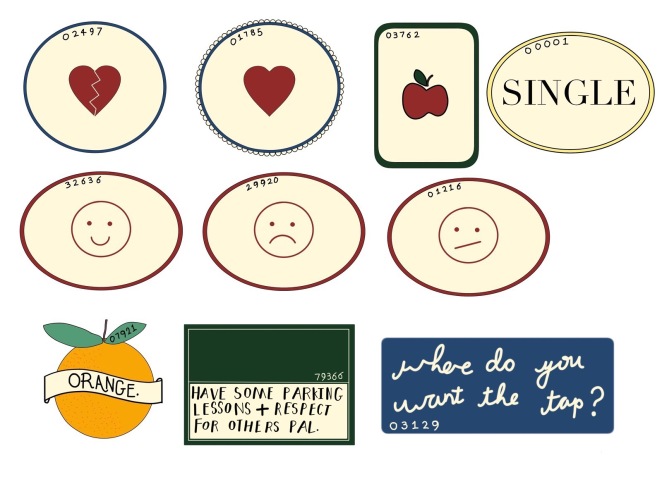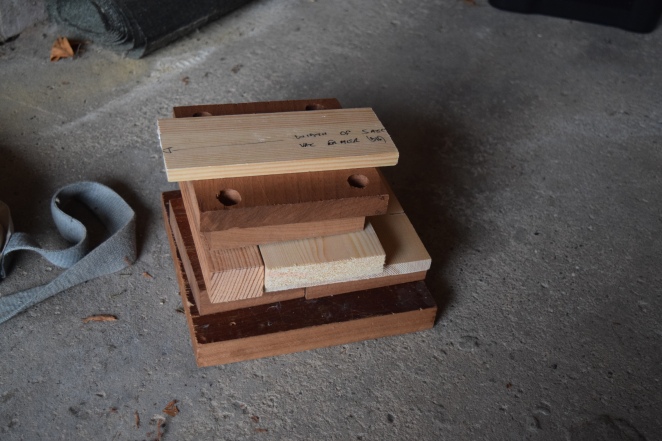The Museum Of Mary Birch
The Museum Of Mary Birch explores ideas surrounding ownership, strangers, and obsession. It contains stories created by me and documents that surround one object, a sugar jar, that intertwine to depict parts of Mary Birch’s life.
The Museum
I had the individual elements and decided the best way to present them would be in this ‘Museum Of Mary Birch’ or ‘MOMB.’ Initially I was just going to create the museum in the studio with the stereotypical plinths and descriptions however as I began to refine my ideas this theme of obsession recurred. I decided the best way to portray my idea would be to put the museum in my bedroom to suggest the idea of a personal obsession that can be linked to trivial ‘obsessions’ such as when we cover our bedroom walls in posters of our favourite band or more serious addictions that can consume our life. It also links to ideas surrounding our secretive lives, parts of ourselves that few people ever discover: hidden behind closed doors.
The museum is useless of course; I made posters but it isn’t advertised anywhere and nobody really visits but me. This lack of visitors makes it a self indulgent endeavour rather than an educational facility for the curious mind. The direction of my project took a much more obsessive quality towards the end as I refined my ideas. This obsession with the unknown Mary Birch, unreachable yet taking over my home, highlighting how desire for discovery and consumption can drive us insane. The museum is mine in a sense but more belongs to an exaggerated version of myself. Of course I became increasingly curious about this Mary Birch however obviously I wouldn’t create a shrine like museum celebrating her life. The posters I made aren’t meant for advertisement purposes but are more of a way to validate the importance of this obsession. It represents the notion that other people would also accept this idea and want to be a part of it rather than just an idea consuming a single person’s mind. These posters along with the gift shop and using the plinth as a presentation method gives the museum value, making it seem acceptable and worthwhile to my exaggerated self. The gift shop also discusses ideas surrounding consumerism and our obsession with money in today’s society.
I started a series of photographs to represent how obsession or addiction whether that be to a physical object, an idea, or a human being can be detrimental not only to the affected person but to those around them. The Museum Of Mary Birch began to intertwine itself into the lives of people who live with me. The gift shop lives alongside our groceries in the fridge, family photos are placed alongside Dick Roughley, his delivery van, and the church roof in Digmoor, and the piano has become public property labelled: ‘PLAY ME I’M YOURS.’
I wanted to have an alternative way of displaying my work outside of my bedroom and so presented it in an everyday cardboard box as if someone is moving house labelled ‘MOMB.’ It is filled with the contents of the museum and my documentation of it. It becomes an artwork in itself as well as a presentation method as it surrounds the idea of ‘hidden in clear view’ and attaches itself to the idea of when people hide their treasured objects in memory boxes. It becomes this secret obsession hidden away yet linked to the fact that it is important enough not to be left behind. It also renders the museum even more useless than it already was and effectively explores thoughts surrounding our private and secretive lives and disconnecting ourselves from others. Especially with obsession/addiction it may be common to be embarrassed by what has taken over our lives and we might hide it away.
Mary Birch didn’t reply to my letter asking about her and so to add an element of truth to my stories I sought the assistance of wigan world. Wigan World is an online forum where residents or ex residents discuss their present lives or share nostalgic tales about the area where the address in Mary Birch’s book links to. Initially I visited the site to see if I could find Mary Birch and although unsuccessful there were some interesting posts and photos about the area that I could incorporate into my stories. This bending of the truth would make my stories more believable although this wasn’t my main priority. I did want the stories to be far fetched and childlike as I wanted to be inspired by the book that inspired the project: A Tale Of Green Hedges, a children’s book by Enid Blyton. I also wanted to discuss ideas surrounding obsession with a person. If we’re so infatuated by somebody we may be reluctant to see past the facade and believe every word they say even if it is untrue. Especially with romantic relationships it may be easy to become dependent on someone, become intertwined in their life and lose parts of ourself. We may either be obsessed with the person or with the idea of the person but lose a sense of reality and be hesitant to know the truth. It may be hard to let go even if the results will be more detrimental in the long run.
Characters
Richard Roughley
I found Richard Roughley on wigan world. Someone had uploaded an album of old photos and he is featured standing next to his delivery van. I gave him the address 12 Daniel’s Lane which is a street near where Mary Birch lived.
Mary Birch
Address: 2 Spencer’s Lane, Digmoor, Upholland, Near Wigan
Found in a book I bought from a charity shop
Joseph Guest
When looking a old electoral records on wigan world I found a Mr. Joseph Guest who lived at 3 Spencer’s Lane.
The Stories
I chose to focus my tales on one object: The Sugar Jar, that I bought from a charity shop. The first poem like story follows Richard Roughley tearing the pages out of Mary’s book and burying them in the ground along with his mother’s sugar jar, dated 1956.
The next visual story shows a lost poster made by Mrs Roughley searching for her beloved sugar jar, dated 1956.
Then there are letters sent between Richard and Mary, dated 1964. Richard sends Mary her book pages in the post along with the sugar jar. Mary responds explaining that she’s not sure what she is to do with the surprise gift.
The last story, ‘The Sugar Jar’, dated 1989 follows Mary Birch and Joseph Guest. Joseph takes Mary’s sugar jar but then gives it back.
I chose to write the stories this way to challenge the idea of ownership and the fragility of possession. Like most of my artworks The Museum Of Mary Birch explores this idea of the readymade, adding meaning to arbitrary objects, and making them art. I chose one object to pass through ‘owners’ leaving the reader questioning who the sugar jar really belongs to and what the concept of ownership really means.
I also wanted an object to be the main focus of the stories to highlight how objects can very much define who we are. Especially in today’s consumeristic society we’re obsessed with having and owning the new, often expensive, things that apparently make us ‘cool’ and fit in.
These intertwined stories also bring up ideas about connecting with strangers and discovering new stories about people. We’re surrounded by thousands of untold stories everyday yet often are too busy searching for the chair with nobody sitting either side of it or avoiding eye contact in the street.
(The Events that took place in 1956)
Tales of Green Hedges 1956
Richard dug and dug and dug
Further into the ground.
He tore the pages out of Mary’s book and buried them.
And then covered his mother’s sugar jar with the remaining soil.
Letters between Mary Birch and Richard Roughley
Dear Mary,
I went digging at the weekend and found some things that I believe belong to you. I’m sorry I tore the pages out of your book but please accept my apology and this sugar jar as a token of my regret.
Sincerely yours,
Dick Roughley
Dick,
Thanks, although I’m unsure what I will do with the pages, I’m not sure if they are of use to me anymore. Thanks for the sugar jar.
Mary
The Sugar Jar
The air was grey. A stone lay on the carpet so the top left hand corner of the doormat couldn’t touch the floor. The fish hadn’t been fed. And the sugar jar was missing. The sugar jar with the oranges on: Mary’s favourite. It was made by Tyne Potteries and had the word ‘sugar’ on it, hence why it had been dubbed the sugar jar in the Birch household. They kept sugar in it. Joseph Guest from 3 Spencer’s Lane, the next door neighbour, was a renowned thief and so on the morning of January 26th 1989 Mary Birch knocked on his door.
“Where is my sugar jar?” she said.
“It’s in my kitchen” Mr Guest replied. He slammed the door shut. He then opened the door and slammed it shut again.
Mary and Joseph had never been friends, although they once helped repair the St Thomas The Martyr Church roof where they had attended bible classes together. Joseph went to Digmoor methodist church now near where they both went to village school. Across the road from the village school was a footpath. Mary remembered her friend falling into the nettles while trying to cross the stile, perhaps that was a seed that lead her to her job as a Rights of way Officer for Derbyshire Countryside Service. She was always exploring and once walked all the way to the road sign of the next village and felt a great sense of achievement. There was a tradition of the children pulling as many peas off the pea wagon as it passed by along the road.
Mary drew her finger along the bookcase and pressed her thumb and forefinger together. A fine layer of dust was forming where her beloved sugar jar used to lie. A layer of dust so fine that it was not visible on Mary’s fingertips. She could still feel it. She could feel it in her soul. Her dusty soul.
Hours had past without much movement so Mary went to the bakery at the bottom of Daniel’s Lane where she purchased two loaves of bread and a coconut. As she was walking home she noticed part of the kerb had detached itself from the pavement and then she looked up only to see Joseph Guest. He laughed. She tried to cry but she couldn’t. They walked back home together. Joseph was Mary’s 2nd husband and he lived in the kitchen.
Mary hadn’t cooked for many years; Joseph would make the food and then pass it to Mary through a hole in the wall he had created with a hammer and chisel. They seldom spoke but when they did it was about how puffins are like squashed versions of toucans. Later that evening no food arrived through the hole in the wall but Mary’s sugar jar did. The sugar jar with the oranges on: Mary’s favourite.
Epilogue
It’s a shame that Mary Birch or whoever lives at that address didn’t respond as I think that would’ve added another element to my work. I could’ve featured the letters between Mary Birch and Laura Emsley which would’ve linked the work to this imaginary persona I created around myself. I would’ve liked to take this project further perhaps making more stories that fill in gaps or adding other media such as sound or video clips.
It would also be interesting to redo this project from a different angle and create more lifelike stories and try to convince people they were real or pretend I had found Mary Birch and tell them about her life that I had supposedly discovered.






